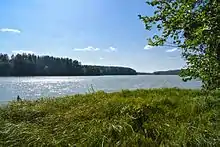Central Federal District
The Central Federal District (Russian: Центра́льный федера́льный о́круг, tr. Tsentralny federalny okrug, IPA: [tsɨnˈtralʲnɨj fʲɪdʲɪˈralʲnɨj ˈokrʊk]) is one of the eight federal districts of Russia. The word "Central" has a political and historical meaning, being the core of the Russian state and its predecessor, the Grand Duchy of Muscovy. Geographically, the district is situated in the extreme west of present-day Russia; although it can be considered as the central region of European Russia. The district covers an area of 650,200 square kilometers (251,000 sq mi),[1] and recorded a population of 38,427,537 (81.3% urban) in the 2010 Census.[2] The Presidential Envoy to the Central Federal District is Igor Shchyogolev.

Central Federal District
Центральный федеральный округ | |
|---|---|
.svg.png.webp) | |
| Country | |
| Established | 18 May 2000 |
| Administrative Centre | Moscow |
| Government | |
| • Presidential Envoy | Igor Shchyogolev |
| Area | |
| • Total | 650,200 km2 (251,000 sq mi) |
| Area rank | 6th |
| Population | |
| • Total | 38,427,539 |
| • Rank | 1st |
| • Density | 59/km2 (150/sq mi) |
| • Urban | 81.3% |
| • Rural | 18.7% |
| Federal subjects | 18 contained |
| Economic regions | 2 contained |
| HDI (2018) | 0.846[3] very high · 1st |
| Website | cfo |
Demographics
Federal subjects
The district comprises the Central and Central Black Earth economic regions and eighteen federal subjects:
.svg.png.webp) | |||||
|---|---|---|---|---|---|
| # | Flag | Federal subject | Area in km2[1] | Population | Administrative center |
| 1 | Belgorod Oblast | 27,100 | 1,511,620 | Belgorod | |
| 2 | Bryansk Oblast | 34,900 | 1,378,941 | Bryansk | |
| 3 | Vladimir Oblast | 29,100 | 1,523,990 | Vladimir | |
| 4 | Voronezh Oblast | 52,200 | 2,378,803 | Voronezh | |
| 5 | Ivanovo Oblast | 21,400 | 1,148,329 | Ivanovo | |
| 6 | Kaluga Oblast | 29,800 | 1,041,641 | Kaluga | |
| 7 | Kostroma Oblast | 60,200 | 736,641 | Kostroma | |
| 8 | Kursk Oblast | 30,000 | 1,235,091 | Kursk | |
| 9 | Lipetsk Oblast | 24,000 | 1,213,499 | Lipetsk | |
| 10 | Moscow | 2,600 | 10,382,754 | Moscow | |
| 11 | Moscow Oblast | 44,300 | 6,618,538 | None; most public authorities located in Moscow, subject administration located in Krasnogorsk | |
| 12 | Oryol Oblast | 24,700 | 860,262 | Oryol | |
| 13 | Ryazan Oblast | 39,600 | 1,227,910 | Ryazan | |
| 14 | Smolensk Oblast | 49,800 | 1,049,574 | Smolensk | |
| 15 | Tambov Oblast | 34,500 | 1,178,443 | Tambov | |
| 16 | Tver Oblast | 84,200 | 1,471,459 | Tver | |
| 17 | Tula Oblast | 25,700 | 1,675,758 | Tula | |
| 18 | Yaroslavl Oblast | 36,200 | 1,367,398 | Yaroslavl | |
Economy
As of 2018, the GDP in Central Federal District reached RUB29 trillion($400 billion)[4][5] and $10,000 per capita.
References
- "1.1. ОСНОВНЫЕ СОЦИАЛЬНО-ЭКОНОМИЧЕСКИЕ ПОКАЗАТЕЛИ в 2014 г." [MAIN SOCIOECONOMIC INDICATORS 2014]. Regions of Russia. Socioeconomic indicators – 2015 (in Russian). Russian Federal State Statistics Service. Retrieved 26 July 2016.
- Russian Federal State Statistics Service (2011). "Всероссийская перепись населения 2010 года. Том 1" [2010 All-Russian Population Census, vol. 1]. Всероссийская перепись населения 2010 года [2010 All-Russia Population Census] (in Russian). Federal State Statistics Service.
- "Sub-national HDI – Area Database – Global Data Lab". hdi.globaldatalab.org. Retrieved 18 March 2020.
- "Валовой региональный продукт::Мордовиястат". Mrd.gks.ru. Retrieved September 26, 2017.
- "• EUR RUB average annual exchange rate 1999–2018 | Statistic". Statista.com. Retrieved September 29, 2017.
External links
| Wikimedia Commons has media related to Central Federal District. |
- Official site: Federal Cadaster Center of Russia (in Russian)
- Baikaland at Tripod.com at the Wayback Machine (archived February 20, 2007)